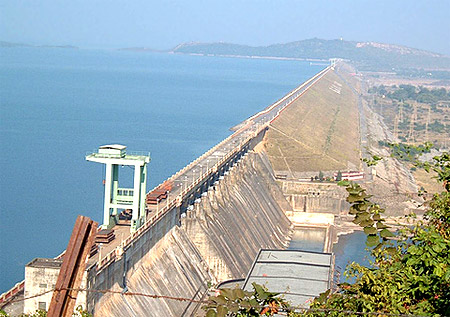The Mahanadi River System rises in the Indian state of Chhatisgarh and then flows in the eastward direction, cutting a ravine in the Eastern Ghat. Before joining the Bay of Bengal at False Point through several channels, the river enters the plains of Orissa near Cuttack and forms a delta. This delta is one of the largest mangrove forests in peninsular India, and also a rice producing area. The term `Mahanadi` means Great River and it is truly one of the largest rivers in southeast India and the sixth largest in India. The Tel and the Hadso are the main tributaries of the Mahanadi. Maharashtra, Chhatisgarh, Jharkhand and Orissa share are drained by the Mahanadi.
 The river flows for 560 miles (900 kilometers) and the drainage area of the river is estimated to be 51,000 square miles (132,100 square kilometers). The world`s largest earthen dam Hirakud Dam is built across this river in Sambalpur. The dam controls the flow of Mahanadi and produces hydroelectricity. The Mahanadi River is one of the most active silt-depositing streams in India. It also supplies several irrigation canals, near Cuttack. The popular pilgrimage destination, Puri is located at one of its mouth.
The river flows for 560 miles (900 kilometers) and the drainage area of the river is estimated to be 51,000 square miles (132,100 square kilometers). The world`s largest earthen dam Hirakud Dam is built across this river in Sambalpur. The dam controls the flow of Mahanadi and produces hydroelectricity. The Mahanadi River is one of the most active silt-depositing streams in India. It also supplies several irrigation canals, near Cuttack. The popular pilgrimage destination, Puri is located at one of its mouth.
The river Mahanadi marks the southern boundary of the Chhatisgarh district clearly. River Brahmani enters the district through Rengali reservoir, passes through Talcher sub- division. Both these great rivers have too many tributaries, both large and small. Pallahara and Talcher Sub-Divisions and a major portion of Angul Sub-division form a part of Brahmani basin, which is also a part of Mahanadi river basin. The basin of Mahanadi is spread over Athamallik Sub-division and some regions of Angul Sub-division.
Mahanadi and its tributary the Brahmani River are perennial rivers. A multi purpose dam has been build over the Brahmani at Rengali. 250 MW of electricity is usually generated at Rengali hydropower station. A barrage has been constructed at 35 Kms. down stream at a place called Samal. This irrigation project is designed to irrigate around 3,36,400 hectares of land in Angul, Cuttack, Dhenkanal, Jajpur and Keonjhar districts. Other rivers of Angul are mountain streams, which during the monsoon months and in the summer contain little or no water. Their banks in the most part are highlands. Their beds are rocky and they are not accustomed for the purpose of navigation.



















